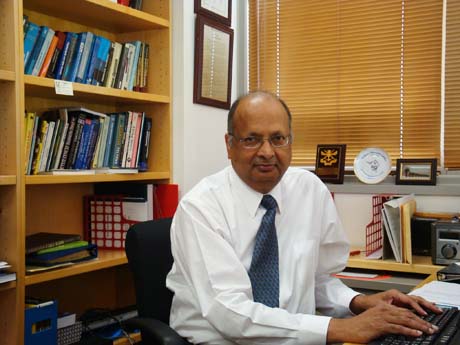
He is recognized for his 1992 patent on MIMO which is key to broadband and 5G today.
Joins exclusive club of wireless pioneers that includes Jagdish Chandra Bose -- and Marconi
Bangalore, January 29 2017: India-born Stanford University emeritus Professor Arogyaswami Paulraj, has been inducted into the National Inventors Hall of Fame of the United States Patent Office. The NIHoF honours "people responsible for the greatest technological advances that make human, social and economic progress possible" and cites Paulraj for his 1992 US patent on MIMO -- Multiple In-Multiple Out -- wireless technology.
This uses multiple antennas both at the transmitter and receiver in a wireless link to boost wireless data rates. The ubiquitous broadband wireless internet access we enjoy today -- and 5G in the near future -- would not be possible without MIMO technology. It has become the basis of all current and future wireless networks, making it the most influential wireless technology in recent decades.
The US Patent and Trademark Office (USPTO) goes back to 1791 and has so far issued more than 8.8 million patents. But as of today, just 561 inventors have been inducted into its Hall of Fame including Thomas Edison, the Wright Brothers, Alexander Graham Bell and Apple co-founder Steve Jobs.
Paulraj joins eight other famed inventors in wireless technology, inducted to the Hall of Fame: Guglielmo Marconi, Oliver Lodge (Wireless Telegraph), Reginald Fessenden (AM radio), Edwin Armstrong (FM Radio), Amos Joel (Cellular tech.) , Andrew Viterbi and Irwin Jacobs (CDMA – 3G), Jan Haartsen (Bluetooth). US patent holding wireless pioneers include another Indian -- Dr Jagdish Chandra Bose for his breakthrough work in radio and microwave optics in 1904.
The formal induction takes place in Washington DC on May 3.
Born in Pollachi, Tamil Nadu, India, in 1944, Paulraj joined the Indian Navy at age 15. Impressed with his academic record, the Navy sent him to the Indian Institute of Technology (Delhi), where he earned a Ph.D. for advances to signal filtering theory. He served the Indian Navy for 25 years where he led the development of the world-class APSOH sonar, one of India’s most successful military development projects. He also founded three national laboratories spanning High Speed Computing, AI and Robotics and Military Electronics.
He joined Stanford University (US) in 1992 where he did all of his work on MIMO. Currently professor emeritus at Stanford. He holds 79 patents and has won several global distinctions. These include both the two top global honors for telecom pioneers – the 2011 IEEE Alexander Graham Bell Medal and 2014 Marconi Prize and Fellowship. Paulraj’s recognitions in India include the Padma Bhushan in 2010.
About his induction, Paulraj says: "The NIHoF recognition is a wonderful honour. I feel enormously humbled to be counted among the inventors who have made the modern world possible. When I joined Stanford in 1992, I had not worked in wireless technology, since my prior years in India were spent on sonar systems with brief forays into AI and Computing. It was perhaps being an outsider that helped me come up with this transformative idea. Like many big breakthroughs, MIMO faced significant skepticism for a few years, but it eventually took off and is now the foundation of all wireless systems."
In recent months, Paulraj has been actively helping India in preparations for the rollout of 5G: He adds: "The Department of Telecom has asked me to support their efforts to advance the applications and internal value addition in 5G wireless. I am very grateful for this opportunity. I have always felt that India needs to join the club of countries like US, China, Europe, S Korea and Japan that dominate communications and computing technology."
Last month Paulraj asssumed a role as chairman of the Department of Telecom's Steering Committee "to deliberate and finalise Vision, Mission, Goals and Roadmaps for 5G India 2020".
Says Telecom Secretary Aruna Sundararajan : "We in India are truly privileged to have Dr Paulraj guiding the DoT and the Government of India at this point in time and for taking the time out to help us put India on the 5G global map".